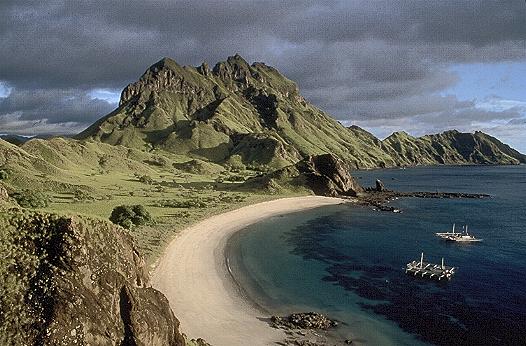The Near Extinction and Protection of the Ora
It is a well known fact that in the history of the world, Europeans enjoyed taking over countries, hunting wild animals to the brink of extinction for sport, and becoming a general annoyance to everyone. When the Dutch were in Indonesia, it was suggested that oras be used for handbags, purses, exotic meals, and hunting trophies. The last of the two, all thought they did not take as many animals, were in effect until the 1930's or later. Fortunately for the dragons, their skin is not good for tanning. It cracks, breaks, and put quite frankly, makes an ugly purse. And so the oras were not used for purses and spared extinction. However, dragons were killed by the rich Dutch who had the money to go down to Komodo and kill them. And so about 600 a year were taken, until a law went into effect saying that only 5 dragons could be taken in a year. The Dutch recognized this animal as a valuable ecological predator and set up laws protecting it. Now, the same rules applies; and although there isn't a lot of demand for ora hunting, those who want to do it are usually discouraged. Intimidated by the fact that one has to go to the government, fill out forms, get the blessings of the President, the Sultans, and so on.
Now the dragons are protected for another reason than the one the Dutch had when they made their laws. The Indonesians could care less about protecting animal life. I have been to places in Java where you can buy stuffed cobras attacking rare birds (also stuffed) for relatively cheap prices. These people could theoretically exterminate any species without remorse. But not this one. Because money is such a valuable resource over there, and the oras are so popular with the tourists, the people of Indonesia would be idiots to make them defunct. If they did, they would see thousands of tourists and tourist dollars float away before their eyes. So the dragons are too valuable economically to kill off. This has some good and bad points. The good part was mentioned above; we will probably have wild oras around for a long time. |
| The Tourist Version of the Ora
The bad part is that the money here comes from tourists, and tourists, aside from making Komodo Island a side-show, have a greater impact. Let's just say that when most people go halfway around the world to see the largest, smartest reptile, they don't want to fall victim to it. The last dragon casualty was in 1973, and the rangers have done a pretty good job of keeping people safe. With the exception of a dragon eating a little girl on the outskirts of Komodo Village, the dragons are pretty much domesticated. The average tourist can walk right up to them and get an exotic picture of an ora sunning itself. These dragons are calmed, their wild side appeased by the rangers of the park. They are fed deer to keep them calmed and prevent any more accidents, which would destroy the image of the park. The feedings are also at a certain spot, so when a guide takes a group of tourists there, they are assured that there are dragons there, waiting for their meal. The meal used to be a goat tossed in a pit in front of tourists, but now it is done in private. So unfortunately, the dragons that visitors see are rarely the wild ones. |
| The Ugly Side of the Ora
The dragon has gone through several changes during the last couple decades. One of them has been, as mentioned above, the semi-domestication of this animal. However, they were not always that way, which makes for some pretty good stories about dragons attacks, casualties, close calls, and so on. Since these are interesting (and sort of creepy) I will share some of the ones I know in this section. Note: You know how these type of stories are. They are handed down from one person to the next, each time a slight change or an element added. So just keep in mind that what you are reading below was passed down through several people, and a "tall tale" may be present.
In 1973, a Swiss tourist and a guide were hiking through Komodo island. He was an elderly man, and for a few thousand rupiah (no more than a few dollars) he could hire a personal guide to take him through the park. The hike was going fine, and no dragons sighted yet, but they continued. On part of the hike, the man fell and injured his knee/ankle on a rock during the fall.
The guide stopped, looked at the wound, and ran down the mountain to get help. This was the big mistake. I really don't know what the guide should have done, but when he took off down the mountain, the man was in trouble.
Oras have an incredible sense of smell. They are able to smell things very far away and reach the scent as quickly as possible. When they arrive at a fresh kill, they are able to consume half of their body weight in 20 minutes. Their deadly saliva and hinged jaws, like those found in an egg eating snake, enable them to consume prey as quickly as possible. So unfortunately, when the guide came back to the spot were the man fell, they (him and the 'rescue team') found only a backpack and a puddle of blood.
That was the last tourist casualty by a dragon to date. Although, a few years ago, a small girl was dragged away by a dragon while she was playing on the outskirts of Komodo Village. The dragons of Komodo island are also said to be a bit more edgy during the course of the last year or so, a symptom indirectly related to humans. The most visited area of the island used to be a feeding center, now defunct. Tourists could go inside a caged area for protection from the dragons. It used to be set up so that one could "buy" some food for the oras. This usually involved a transfer of what would seem like a small amount of money to a tourist, who would purchase a deer killed by the locals. The dead deer was then tossed into a pit where the dragons would get a free meal without working. Visitors from the rim would keep camcorders and cameras running, capturing this gruesome spectacle on film. as you can see, this situation would anyone who loved the Disney movie Bambi scream. So the feeding stopped. The dragons, although still perfectly able to survive in the wild.
We should consider ourselves lucky, though. If, hypothetically, an extinct relative of the ora was still around, tourists visiting Australia would have to cope with a bigger beast. The creature, which was the largest reptile ever to have lived on earth, is known by the genus name of Megalania. The Megalania was twice as long as the ora of today, and at least 5 times as bulky. Living until late Pleistocene times, the Megalania was undoubtedly the chief predator of its time. The Megalania, however, went out with a whimper, a victim of a probable ecological or environmental catastrophe. |
| The Hard Facts (and some widely distributed myths)
Being the king of the mountain sometimes isn't enough. So let me warn you here, some of the "facts" below may exaggerated slightly.
Dragon facts:
| The largest dragon found and confirmed by science was 10' 2.5''. |
| The saliva of an ora contains four forms of bacteria with no known antidotes. |
| The teeth of an ora are arranged so that the maximum amount of flesh can be bitten off and swallowed whole. |
| An ora can run faster than 15 m.p.h. |
| Oras smaller that 3' are fully capable to climb trees. |
| Aside from humans, oras are the only animals that willingly control their population (by way of eating their eggs). |
| Oras are also cannibals, eating other members of their species. |
| In ecological disasters [such as a titanic fire] oras have been known to swim to other islands for safety. |
| Although not confirmed by science, claims are made that the ora is a good swimmer. Some Indonesians refer to the ora as a "water crocodile"; some state that the dragon can travel relatively long distances in water, sometimes diving 12' or more. |
| Komodo Dragons, or at least their near relatives, have existed since the Jurassic period.
In conclusion, the Komodo Dragon is not only the largest reptile in the world, but a very fascinating one. They are a spectacular living example of the biodiversity of our planet, and although are in no current danger, should be preserved in their natural form and temperament for future generations and ecologists to observe.
Welcome To Indonesia Tourism....
| |


